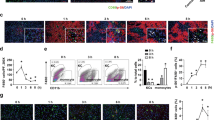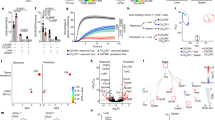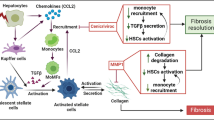Abstract
Activated cytotoxic T-cell-mediated hepatocyte apoptosis via Fas/Fas-ligand and perforin/granzyme pathways are believed to involve the model of concanavalin A (ConA)-induced hepatitis. The purpose of the present study is to investigate whether the cytokine response modifier A (crmA) gene effectively inhibits the hepatocyte apoptosis of ConA-induced hepatitis. We examined survival rates, liver pathology, immune histological changes, and cytokine profiles from mice receiving the recombinant adenovirus vectors containing cre and/or crmA genes, transferred to the liver 3 days before ConA injection, and a crmA gene nonexpression control group. Injection of ConA into mice rapidly led to massive hepatocyte apoptosis, and infiltration of leukocytes, especially CD11b+ inflammatory cells. In contrast, liver damage was dramatically reduced in the mice that expressed the crmA gene. However, infiltration by CD4+ cells was not affected. The survival of the mice increased significantly to 100% in the treated group versus the control group. Furthermore, we demonstrated that interleukin (IL)-18 plays an important role in ConA-induced hepatitis, and that crmA expression significantly inhibited IL-18 secretion. Our results showed that the crmA gene effectively inhibits apoptosis induced by ConA hepatitis. This indicates a potential therapeutic usage of crmA for protection from cellular damage due to hepatitis.
This is a preview of subscription content, access via your institution
Access options
Subscribe to this journal
Receive 6 print issues and online access
$259.00 per year
only $43.17 per issue
Buy this article
- Purchase on SpringerLink
- Instant access to full article PDF
Prices may be subject to local taxes which are calculated during checkout






Similar content being viewed by others
References
Tiegs G, Hentschel J, Wendel A . A T cell-dependent experimental liver injury in mice inducible by concanavalin A. J Clin Invest 1992; 90: 196–203.
Tiegs G, Gantner F . Immunotoxicology of T cell-dependent experimental liver injury. Exp Toxicol Pathol 1996; 48: 471–476.
Watanabe Y, Morita M, Akaike T . Concanavalin A induces perforin-mediated but not Fas-mediated hepatic injury. Hepatology 1996; 24: 702–710.
Tagawa Y, Kakuta S, Iwakura Y . Involvement of Fas/Fas ligand system-mediated apoptosis in the development of concanavalin A-induced hepatitis. Eur J Immunol 1998; 28: 4105–4113.
Ksontini R et al. Disparate roles for TNF-alpha and Fas ligand in concanavalin A-induced hepatitis. J Immunol 1998; 160: 4082–4089.
Nicoletti F et al. Essential pathogenetic role for interferon (IFN-) gamma in concanavalin A-induced T cell-dependent hepatitis: exacerbation by exogenous IFN-gamma and prevention by IFN-gamma receptor-immunoglobulin fusion protein. Cytokine 2000; 12: 315–323.
Tagawa Y, Sekikawa K, Iwakura Y . Suppression of concanavalin A-induced hepatitis in IFN-gamma(−/−) mice, but not in TNF-alpha(−/−) mice: role for IFN-gamma in activating apoptosis of hepatocytes. J Immunol 1997; 159: 1418–1428.
Farrar MA, Schreiber RD . The molecular cell biology of interferon-gamma and its receptor. Annu Rev Immunol 1993; 11: 571–611.
Dinarello CA et al. Overview of interleukin-18: more than an interferon-gamma inducing factor. J Leukoc Biol 1998; 63: 658–664.
Okamura H et al. A novel costimulatory factor for gamma interferon induction found in the livers of mice causes endotoxic shock. Infect Immun 1995; 63: 3966–3972.
Okamura H et al. Cloning of a new cytokine that induces IFN-gamma production by T cells. Nature 1995; 378: 88–91.
Ushio S et al. Cloning of the cDNA for human IFN-gamma-inducing factor, expression in Escherichia coli, and studies on the biologic activities of the protein. J Immunol 1996; 156: 4274–4279.
Matsui K et al. Propionibacterium acnes treatment diminishes CD4+ NK1.1+ T cells but induces type I T cells in the liver by induction of IL-12 and IL-18 production from Kupffer cells. J Immunol 1997; 159: 97–106.
Takeda K et al. Defective NK cell activity and Th1 response in IL-18-deficient mice. Immunity 1998; 8: 383–390.
Puren AJ et al. Interleukin-18 (IFNgamma-inducing factor) induces IL-8 and IL-1beta via TNFalpha production from non-CD14+ human blood mononuclear cells. J Clin Invest 1998; 101: 711–721.
Tsutsui H et al. IFN-gamma-inducing factor up-regulates Fas ligand-mediated cytotoxic activity of murine natural killer cell clones. J Immunol 1996; 157: 3967–3973.
Ray CA et al. Viral inhibition of inflammation: cowpox virus encodes an inhibitor of the interleukin-1 beta converting enzyme. Cell 1992; 69: 597–604.
Vaux DL, Weissman IL, Kim SK . Prevention of programmed cell death in Caenorhabditis elegans by human bcl-2. Science 1992; 258: 1955–1957.
Nicholson DW et al. Identification and inhibition of the ICE/CED-3 protease necessary for mammalian apoptosis. Nature 1995; 376: 37–43.
Tewari M et al. Yama/CPP32 beta, a mammalian homolog of CED-3, is a CrmA-inhibitable protease that cleaves the death substrate poly(ADP-ribose) polymerase. Cell 1995; 81: 801–809.
Lowin B, Peitsch MC, Tschopp J . Perforin and granzymes: crucial effector molecules in cytolytic T lymphocyte and natural killer cell-mediated cytotoxicity. Curr Top Microbiol Immunol 1995; 198: 1–24.
Tewari M et al. CrmA, a poxvirus-encoded serpin, inhibits cytotoxic T-lymphocyte-mediated apoptosis. J Biol Chem 1995; 270: 22705–22708.
Fujino M et al. In vitro prevention of cell-mediated xeno-graft rejection via the Fas/FasL-pathway in CrmA-transducted porcine kidney cells. Xenotransplantation 2001; 8: 115–124.
Li XK et al. Inhibition of Fas-mediated fulminant hepatitis in CrmA gene-transfected mice. Biochem Biophys Res Commun 2000; 273: 101–109.
Galle PR et al. Involvement of the CD95 (APO-1/Fas) receptor and ligand in liver damage. J Exp Med 1995; 182: 1223–1230.
Gantner F et al. Concanavalin A-induced T-cell-mediated hepatic injury in mice: the role of tumor necrosis factor. Hepatology 1995; 21: 190–198.
Kusters S et al. Interferon gamma plays a critical role in T cell-dependent liver injury in mice initiated by concanavalin A. Gastroenterology 1996; 111: 462–471.
Mizuhara H et al. T cell activation-associated hepatic injury: mediation by tumor necrosis factors and protection by interleukin 6. J Exp Med 1994; 179: 1529–1537.
Mizuhara H et al. Critical involvement of interferon gamma in the pathogenesis of T-cell activation-associated hepatitis and regulatory mechanisms of interleukin-6 for the manifestations of hepatitis. Hepatology 1996; 23: 1608–1615.
Seino K et al. Contribution of Fas ligand to T cell-mediated hepatic injury in mice. Gastroenterology 1997; 113: 1315–1322.
Ogasawara J et al. Lethal effect of the anti-Fas antibody in mice. Nature 1993; 364: 806–809.
Trautwein C et al. Concanavalin A-induced liver cell damage: activation of intracellular pathways triggered by tumor necrosis factor in mice. Gastroenterology 1998; 114: 1035–1045.
Jones RA et al. Fas-mediated apoptosis in mouse hepatocytes involves the processing and activation of caspases. Hepatology 1998; 27: 1632–1642.
Bradham CA et al. Mechanisms of hepatic toxicity. I. TNF-induced liver injury. Am J Physiol 1998; 275: G387–G392.
Lemasters JJV . Necrapoptosis and the mitochondrial permeability transition: shared pathways to necrosis and apoptosis. Am J Physiol 1999; 276: G1–G6.
Ekert PG, Silke J, Vaux DL . Inhibition of apoptosis and clonogenic survival of cells expressing crmA variants: optimal caspase substrates are not necessarily optimal inhibitors. EMBO J 1999; 18: 330–338.
Dbaibo GS, Hannun YA . Cytokine response modifier A (CrmA): a strategically deployed viral weapon. Clin Immunol Immunopathol 1998; 86: 134–140.
Fujino M et al. Distinct pathways of apoptosis triggered by FTY720, etoposide, and anti-Fas antibody in human T-lymphoma cell line (Jurkat cells). J Pharmacol Exp Ther 2002; 300: 939–945.
Ekert PG, Silke J, Vaux DL. Caspase inhibitors. Cell Death Differ 1999; 6: 1081–1086.
Dbaibo GS et al. Cytokine response modifier A (CrmA) inhibits ceramide formation in response to tumor necrosis factor (TNF)-alpha: CrmA and Bcl-2 target distinct components in the apoptotic pathway. J Exp Med 1997; 185: 481–490.
Quan LT et al. Granzyme B is inhibited by the cowpox virus serpin cytokine response modifier A. J Biol Chem 1995; 270: 10377–10379.
MacDonald G et al. Mitochondria-dependent and -independent regulation of Granzyme B-induced apoptosis. J Exp Med 1999; 189: 131–144.
Fiorucci S et al. NO-aspirin protects from T cell-mediated liver injury by inhibiting caspase-dependent processing of Th1-like cytokines. Gastroenterology 2000; 118: 404–421.
Chisari FV, Ferrari C . Hepatitis B virus immunopathogenesis. Annu Rev Immunol 1995; 13: 29–60.
Okamura H et al. Regulation of interferon-gamma production by IL-12 and IL-18. Curr Opin Immunol 1998; 10: 259–264.
Thornberry NA et al. A novel heterodimeric cysteine protease is required for interleukin-1 beta processing in monocytes. Nature 1992; 356: 768–774.
Salvesen GS, Dixit VM . Caspases: intracellular signaling by proteolysis. Cell 1997; 91: 443–446.
Thornberry NA, Lazebnik Y . Caspases: enemies within. Science 1998; 281: 1312–1316.
Alnemri ES et al. Human ICE/CED-3 protease nomenclature. Cell 1996; 87: 171.
Ghayur T et al. Caspase-1 processes IFN-gamma-inducing factor and regulates LPS-induced IFN-gamma production. Nature 1997; 386: 619–623.
Gu Y et al. Activation of interferon-gamma inducing factor mediated by interleukin-1beta converting enzyme. Science 1997; 275: 206–209.
Li P et al. Mice deficient in IL-1 beta-converting enzyme are defective in production of mature IL-1 beta and resistant to endotoxic shock. Cell 1995; 80: 401–411.
Fantuzzi G et al. Interleukin-18 regulation of interferon gamma production and cell proliferation as shown in interleukin-1beta-converting enzyme (caspase-1)-deficient mice. Blood 1998; 91: 2118–2125.
Miwa K et al. Caspase 1-independent IL-1beta release and inflammation induced by the apoptosis inducer Fas ligand. Nat Med 1998; 4: 1287–1292.
Akita K et al. Involvement of caspase-1 and caspase-3 in the production and processing of mature human interleukin 18 in monocytic THP.1 cells. J Biol Chem 1997; 272: 26595–26603.
Ishiwata Y et al. Protection against concanavalin A-induced murine liver injury by the organic germanium compound, propagermanium. Scand J Immunol 1998; 48: 605–614.
Wolf D et al. TNF-alpha-induced expression of adhesion molecules in the liver is under the control of TNFR1 – relevance for concanavalin A-induced hepatitis. J Immunol 2001; 166: 1300–1307.
Kaneko Y et al. Augmentation of Valpha14 NKT cell-mediated cytotoxicity by interleukin 4 in an autocrine mechanism resulting in the development of concanavalin A-induced hepatitis. J Exp Med 2000; 191: 105–114.
Toyabe S et al. Requirement of IL-4 and liver NK1+ T cells for concanavalin A-induced hepatic injury in mice. J Immunol 1997; 159: 1537–1542.
Takeda K et al. Critical contribution of liver natural killer T cells to a murine model of hepatitis. Proc Natl Acad Sci USA 2000; 97: 5498–5503.
Yamamoto S et al. Consistent infiltration of thymus-derived T cells into the parenchymal space of the liver in normal mice. Hepatology 1999; 30: 705–713.
Fogler WE et al. Recruitment of hepatic NK cells by IL-12 is dependent on IFN-gamma and VCAM-1 and is rapidly down-regulated by a mechanism involving T cells and expression of Fas. J Immunol 1998; 161: 6014–6021.
Acknowledgements
We acknowledge Dr Hiromitsu Kimura for his critical comments and useful suggestions. This study was supported by research grants from the Ministry of Health, Labor and Welfare of Japan (12-KO-2, Millennium Project H12-Saisei-016), a Grant-in-Aid (No. 10307030), and a Grant for Organized Research Combination System from the Ministry of Education, Culture, Sports, Science and Technology of Japan.
Author information
Authors and Affiliations
Rights and permissions
About this article
Cite this article
Fujino, M., Kawasaki, M., Funeshima, N. et al. CrmA gene expression protects mice against concanavalin-A-induced hepatitis by inhibiting IL-18 secretion and hepatocyte apoptosis. Gene Ther 10, 1781–1790 (2003). https://doi.org/10.1038/sj.gt.3302067
Received:
Accepted:
Published:
Issue date:
DOI: https://doi.org/10.1038/sj.gt.3302067
Keywords
This article is cited by
-
Dedifferentiation: inspiration for devising engineering strategies for regenerative medicine
npj Regenerative Medicine (2020)
-
Microbial inhibitors of cysteine proteases
Medical Microbiology and Immunology (2016)
-
Inhibition of interleukin-1beta-stimulated dedifferentiation of chondrocytes via controlled release of CrmA from hyaluronic acid-chitosan microspheres
BMC Musculoskeletal Disorders (2015)
-
Control of granzymes by serpins
Cell Death & Differentiation (2010)



